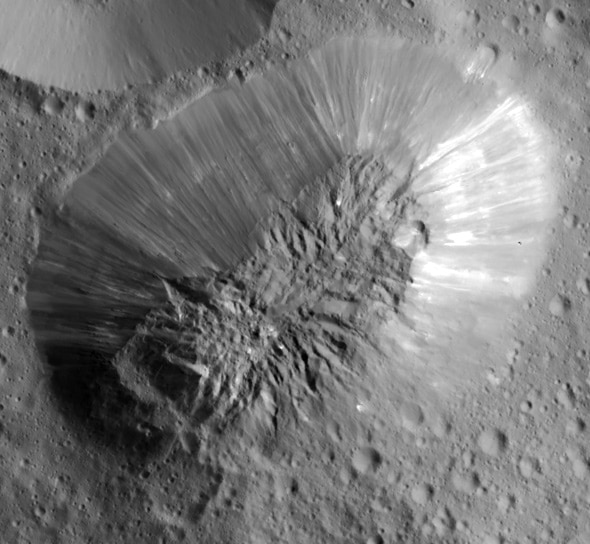Create a free profile to get unlimited access to exclusive videos, sweepstakes, and more!
Why Is There a Huge Mountain on Ceres?

The Dawn spacecraft has dropped itself into its lowest and final mapping orbit around the protoplanet Ceres, and the images it’s now returning are both beautiful and baffling.
We’re still waiting for close-up shots of Occator crater with its bizarre bright spots in it, but in the meantime there’s no lack of weirdness coming from Ceres. The shot above shows Ahuna Mons, a mountain on Ceres 5 kilometers high and 20 kilometers long.
But what the heck is it?
There’s nothing else quite like it on Ceres, and I wouldn’t expect there to be (to be fair, there are other hills that are similar, but nowhere near as big). Ceres is about 950 kilometers across, with a thin rocky crust overlying a thick water ice mantle and a rocky core. The interior isn’t active like Earth’s, so mountain building isn’t something you’d expect. There are features on the surface indicating the crust has experienced some tectonic activity (cracks, depressions, ridges, and so on), but that was long ago.
The images we’ve seen of Ahuna Mons do give us some clues. The flanks are streaked, indicating what geologists call “mass wasting,” flow of material down the sides. There are bright streaks on the right, possibly due to salt—the bright spots dotting the surface of Ceres may be from briny water squeezed out of the interior; the water freezes, then sublimates (turns directly into a gas) in the sunlight, leaving the brighter salt behind. You can see a couple of small nearby craters that are also bright, and a few bright spots on the mountain flanks, too.
Along the top of the image the material seems to stop rather suddenly, but along the bottom it merges more naturally into the native landscape. That may be an illumination effect (the sunlight is coming from the upper right), but it’s hard to say. Interestingly, there appears to be a slope change in the upper flank; it starts off steep, then halfway down the slope changes to be more gradual. I suspect the steeper material is showing us the original mountain, and where the slope changes is where the debris from landslides has piled up.
The top looks rather flat, like a mesa, but that may be a perspective effect since we’re looking straight down on it. An early image taken from the side does seem to point to a flat top. A 3-D animation made by JPL makes it look pointier, but the relief is exaggerated, so may be a little misleading. The JPL press release describes it more as a dome.
Finally, besides the crater to the upper left, the landscape around Ahuna Mons is pretty flat, with gentle, rolling topography. The mountain really sticks out, both literally and figuratively.
So what does all this say? Beats me! But let me speculate a wee bit.
There are a couple of possible explanations. One is that it’s actually the remnants of another asteroid that had a low-speed impact on the surface. But this is pretty unlikely; most impacts are fast enough to do a lot of damage (look at the zillions of craters in the shot!) and getting things just right to leave so much of the impactor intact is just asking too much. Plus, there’s no other damage to the surrounding landscape, which (again due to all the craters seen) must be pretty old. It doesn’t show any resurfacing or anything like that.
The other idea is that it’s some sort of upwelling event from the interior, similar to a volcano on Earth. Maybe there was a crack in the crust there, or it’s just thinner. Water ice from the mantle squeezed up, forming the mountain. Maybe the impact that formed the big crater nearby helped crack the crust down to where the ice could leak out.
Again, I am totally speculating here. Whatever Ahuna Mons is, it’s weird. Pretty much by definition, since it’s unique on Ceres!
We’ll be seeing more data from Dawn over time; it just got into this final mapping orbit a couple of months ago. I’m anxious to see this mountain in different lighting conditions and from different angles. That way a good, high-resolution topographical map of it can be built up, and hopefully its secrets will be revealed.


























